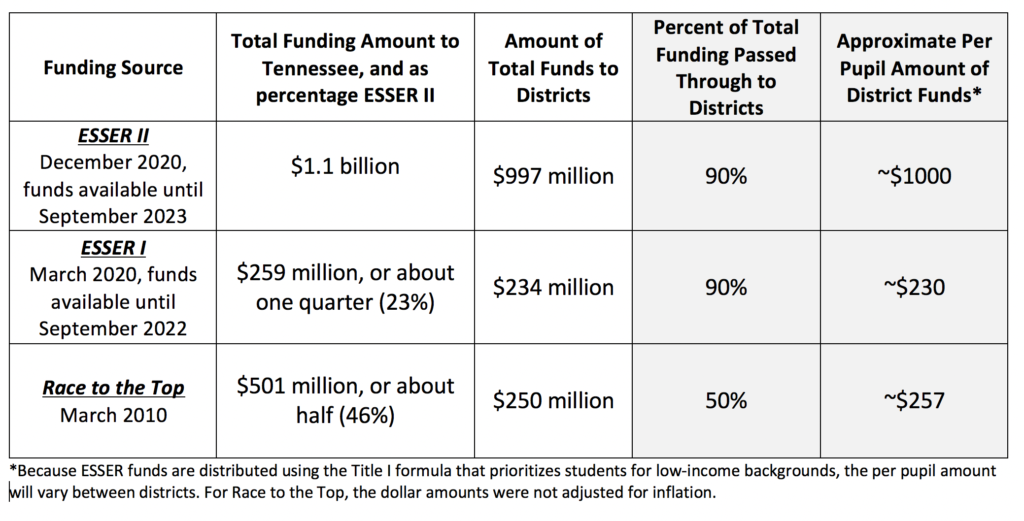
The COVID-19 pandemic continues to bring operational and instructional challenges for school districts as educators and leaders work hard to provide a high-quality education for all students. Economic disruptions from the pandemic may limit the state and local communities’ ability to support K-12 education for the next several years. These twin challenges bring urgency to how schools and districts can best leverage limited education dollars to advance equitable student opportunity and learning — a key question as Tennessee charts a path towards long-term recovery from COVID-19.
On December 27, 2020, the Coronavirus Response and Relief Supplemental Appropriations Act (CRRSA) was signed into law. CRRSA provides around $54 billion for the Elementary and Secondary School Emergency Relief Fund (ESSER II), with Tennessee receiving $1.1 billion. This represents a little over $1,000 per public school student, or about 10 percent of the total annual spending of all of Tennessee’s public schools. These newly secured federal stimulus dollars provide districts in Tennessee the first of several opportunities to align resources with immediate needs as well as plan for long-term education recovery. (Here’s a look at how ESSER I and II compare at the district level.)
To put the ESSER II funds in context:

ESSER II builds on the flexibility provided in ESSER I by adding two key spending priorities around addressing learning loss and school facility repairs and maintenance. These funding flexibilities build on the following allowable uses:
- Providing summer learning and supplemental after-school programs
- Addressing the unique needs of special populations
- Providing mental health services
- Purchasing education technology
- Planning for long-term closures
- Conducting other activities necessary to maintain operation of services, employ existing staff, and coordinate activities
The Tennessee Department of Education has tentatively given school districts a March 1 deadline to submit funding applications. As districts develop spending plans in advance of this deadline, there are two key considerations to maximize use of these funds:
- Make one-time investments with one-time funds to avoid a “fiscal cliff.” ESSER II funds are one-time funds that expire in 2023. School finance experts at the Edunomics Lab point out that while these funds can fill help fill immediate needs, leaders should avoid investments that add to the district’s long-term cost structure and impact the district’s future ability to invest in educators or other priorities. With uncertainties in both the economic outlook and the possibility of additional federal stimulus, districts will need to be ready to respond to future fluctuations in state and local resources for schools in order to avoid this fiscal cliff when federal relief aid expires.
- Invest in practices that aid in long-term recovery, such as high-dosage tutoring. With learning loss expected to be more significant for younger students and in mathematics, districts have the opportunity to try new practices to address targeted student needs. For example, despite a research consensus that high-dosage tutoring remains one of the most promising education practices to support learning recovery and acceleration, few schools or districts have found ways to bring this practice to scale. Using these one-time funds to try out these models will yield long-term dividends for students.
In addition to potential state investments coming out of the Tennessee General Assembly’s special session focused on education, districts will face key investment decisions in the coming months that will impact current student learning and the long recovery work ahead. In a forthcoming COVID-19 Impact Memo, SCORE will outline how school districts can leverage research insights to make the most of their federal stimulus dollars.
Peter Tang is SCORE’s director of research. Madeline Price and Kevin Brown are graduate fellows at SCORE.
Read more:
